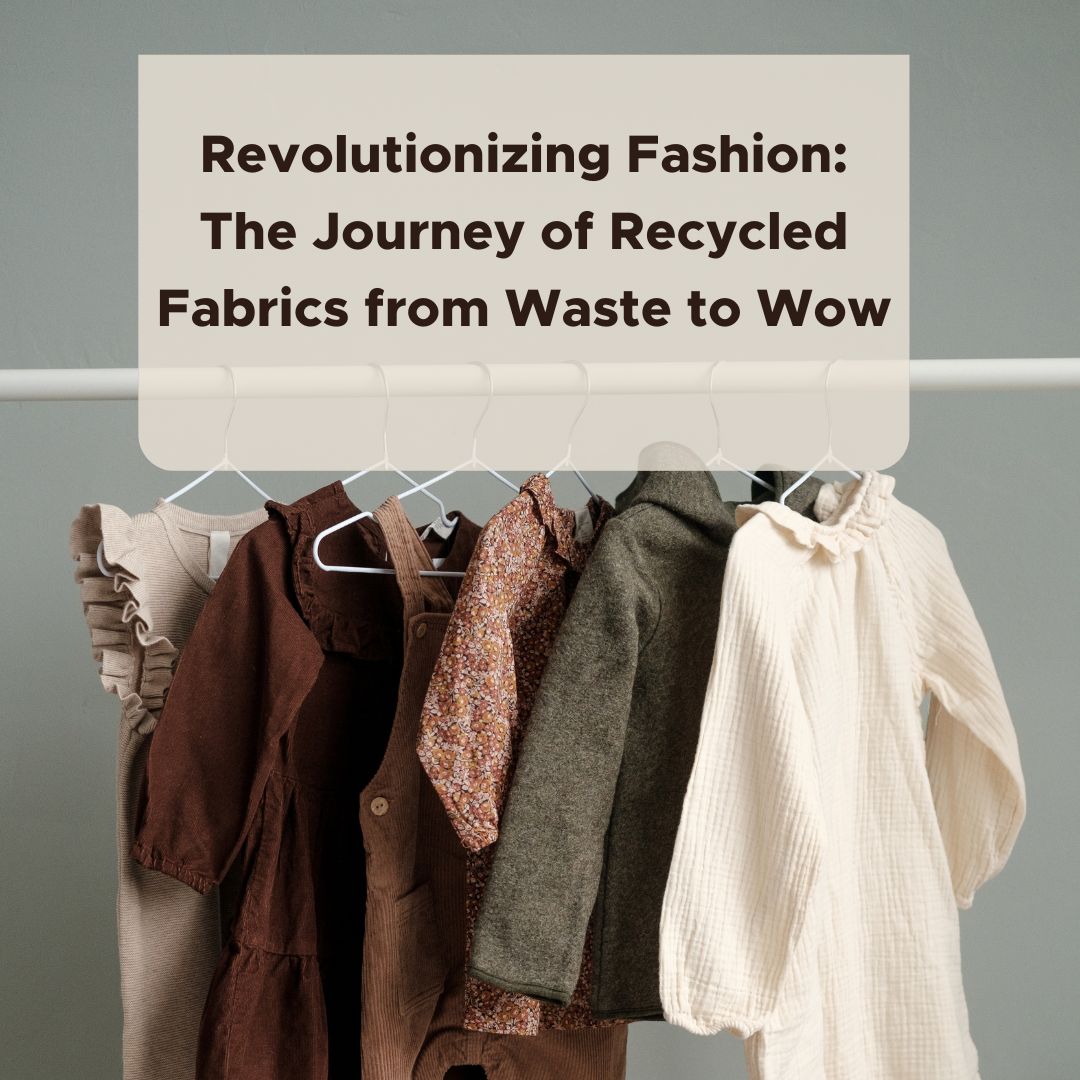
Revolutionizing Fashion: The Journey of Recycled Fabrics from Waste to Wow
The fashion sector is well-known for being one of the most polluters on the planet, with apparel and textile production considerably impacting environmental degradation. As customers become more conscious of fast fashion’s detrimental impact, there is a growing desire for sustainable and eco-friendly alternatives.
Incorporating recycled textiles into designs is one of the most effective methods for fashion companies to lessen their environmental footprint.
This blog will look at the advantages of recycling materials in the fashion business, the many types of recycled fabrics that are available, how to use them in designs, and how to acquire them sustainably.
Benefits of Recycling Fabrics:
There are several benefits of using recycled fabrics in the fashion industry, including:
1. Reducing environmental impact: Recycling textiles helps minimize the amount of trash that ends up in landfills and lessens the demand for virgin materials, which take considerable quantities of energy and resources to generate.
2. Lowering water and energy consumption: The manufacture of new textiles necessitates a significant quantity of water and energy. Businesses may considerably cut their water and energy use and contribute to a more sustainable future by adopting recycled materials.
3. Reducing greenhouse gas emissions: The textile sector is a major source of greenhouse gas emissions, owing mostly to the creation of synthetic fibers. Businesses can reduce their carbon footprint and help combat climate change by adopting recycled textiles.
4. Addressing customer demand: As people become more aware of their environmental effects, they are seeking more sustainable and eco-friendly fashion alternatives. Fashion companies may address this rising need and attract a more environmentally conscious client base by using recycled textiles in their designs.
Types of Recycled Fabrics:
There are several types of recycled fabrics available in the market, including:
- Recycled cotton: Cotton is one of the most widely used fibers in the fashion industry, but its production requires significant amounts of water and energy. Recycled cotton is made by repurposing post-consumer and post-industrial cotton waste, reducing the environmental impact of cotton production.
- Recycled polyester: Polyester is a synthetic fiber commonly used in the fashion industry, but its production requires significant amounts of energy and contributes to greenhouse gas emissions. Recycled polyester is made from recycled plastic bottles, reducing the environmental impact of polyester production.
- Recycled wool: Wool is a natural fiber that is biodegradable and renewable, but its production can have negative environmental impacts. Recycled wool is made by repurposing post-consumer wool garments, reducing waste, and conserving resources.
- Recycled nylon: Nylon is a synthetic fiber commonly used in the fashion industry, but its production requires significant amounts of energy and contributes to greenhouse gas emissions. Recycled nylon is made from post-industrial nylon waste, reducing the environmental impact of nylon production.
How to Incorporate Recycled Fabrics into Your Designs:
Incorporating recycled fabrics into designs requires creativity and innovation. Here are some ways to incorporate recycled fabrics into your designs:
- Use recycled and virgin materials to create one-of-a-kind and eco-friendly creations.
- Utilize recycled materials to create designs that serve a specific function, such as activewear or outdoor gear.
- Using different sorts of discarded textiles to create new textures and patterns.
- Experiment with dyeing: Try various dyeing procedures to produce one-of-a-kind and long-lasting patterns.
How to Source Recycled Fabrics:
Sourcing recycled fabrics can be challenging, but there are several ways to do it sustainably.
Here are some tips for sourcing recycled fabrics:
Work with suppliers: Work with suppliers that specialize in sustainable and eco-friendly materials and can provide you with a range of recycled fabrics.
Attend trade shows: Attend trade shows that focus on sustainable fashion to connect with suppliers and learn about new materials.
Work with local recyclers: Work with local recyclers to source recycled materials locally, reducing transportation emissions and supporting the local economy.
Collaborate with other businesses: Collaborate with other businesses in the industry to source recycled materials and share resources.
Developing a Sustainable Business Model: Incorporating recycled fabrics into designs is just one part of a sustainable business model.
Here are some other ways to develop a sustainable business model:
Reduce waste: Minimize waste in the production process by using efficient production techniques and repurposing waste materials.
Use eco-friendly packaging: Use eco-friendly packaging materials, such as biodegradable or recyclable packaging, to reduce the environmental impact of shipping.
Adopt ethical labor practices: Ensure ethical labor practices throughout the supply chain, including fair wages and safe working conditions for all workers.
Promote transparency: Promote transparency about your business practices and the environmental and social impact of your products.
Conclusion:
Using recycled textiles in designs is an important step toward a more sustainable fashion business. Fashion enterprises may contribute to a more sustainable future by decreasing waste, preserving resources, and satisfying customer demand for sustainable solutions.
Sustainable sourcing of recycled textiles and the development of a complete sustainable business strategy are critical for long-term success in the sector. The International College of Fashion help students in learning sustainability in fashion and encourages future fashion professionals to incorporate sustainable practices into their employment.



